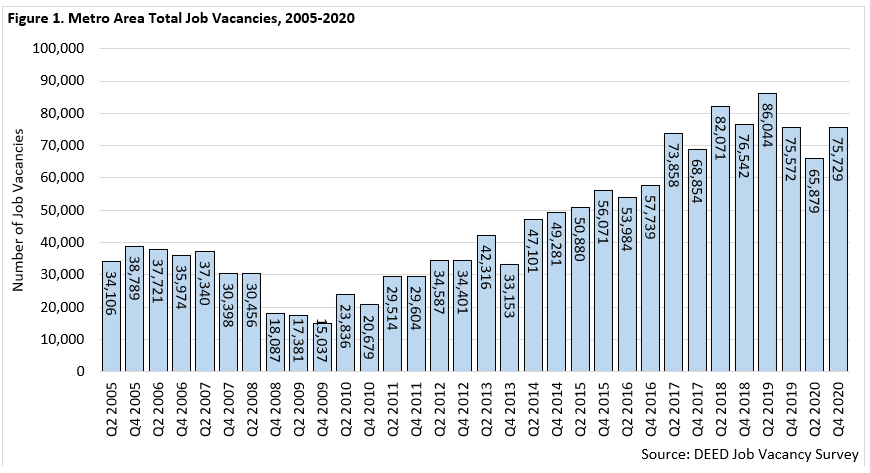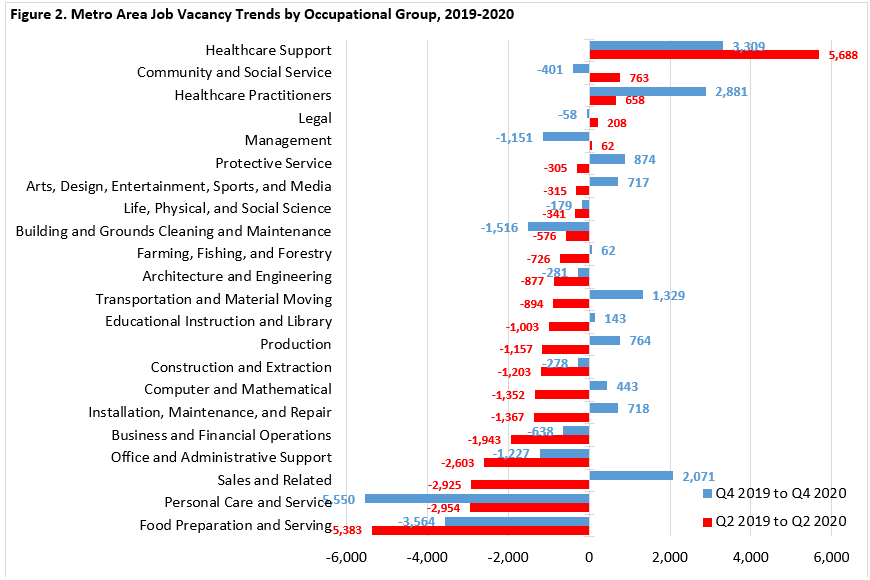 The Minneapolis-St. Paul metropolitan area is a national leader in finance, advanced manufacturing, agriculture and retailing.
The Minneapolis-St. Paul metropolitan area is a national leader in finance, advanced manufacturing, agriculture and retailing.
Medical devices, electronics and processed foods are strong suits recognized globally.
Want the freshest data delivered by email? Subscribe to our regional newsletters.
6/8/2021 9:00:00 AM
Tim O'Neill
Twice per year DEED surveys employers throughout the state to estimate hiring demand and job vacancy characteristics by industry and occupation. Recently released data from the fourth quarter of 2020 shows that employers in the Metro Area reported 75,729 job vacancies, which is the fourth-highest number of job vacancies reported in the region since the job vacancy survey began in 2001.
This comes at a time where the region and state are still recovering from the impacts of COVID-19 on the economy and labor market. Job vacancies did fall to 65,879 in the region during the second quarter of 2020, a drop of 23.4% from the previous year. However, vacancies quickly rebounded through the fourth quarter of 2020 virtually matching the fourth quarter of 2019 (Figure 1).

When broken down by major occupational group, Sales and Related led with 11,634 job vacancies during the fourth quarter of 2020. This was followed by Healthcare Practitioners (7,503 vacancies), Food Preparation and Serving (7,217 vacancies), Healthcare Support (6,413 vacancies), Office and Administrative Support (6,245 vacancies), and Transportation and Material Moving (5,373 vacancies).
Those specific occupations with the most vacancies included Retail Salespersons, Registered Nurses, Cashiers, First-Line Supervisors of Retail Sales Workers, Stockers and Order Fillers, General Maintenance and Repair Workers, Customer Service Representatives, Fast Food and Counter Workers, First-Line Supervisors of Food Preparation and Serving Workers, and Light Truck Drivers. These ten occupations accounted for over one-quarter (28.2%) of the region's total vacancies.
While total job vacancies in the Metro Area returned to pre-pandemic levels during the fourth quarter of 2020, there were significant changes amongst the major occupational groups. Most notably, Personal Care and Service Occupations as well as Food Preparation and Serving Occupations witnessed severe vacancy drops over that period. At the same time the Healthcare Support, Healthcare Practitioners, Sales and Related, and Transportation and Material Moving occupational groups witnessed large increases in vacancies over the year. Those occupational groups that experienced steep job vacancy losses during the second quarter of 2020 followed by equally steep increases during the fourth quarter of 2020 include Computer and Mathematical; Sales and Related; Office and Administrative Support; Installation, Maintenance, and Repair; and Production (Figure 2).

There is no doubt that COVID-19 greatly impacted the Metro Area's labor market, resulting in reduced job vacancies during the second quarter of 2020. This was paired with spikes in the region's unemployment rate, as well as increased claims for Unemployment Insurance (UI) benefits. While job vacancies have returned to normal levels, along with reduced unemployment and claims for UI, there has been a significant shift in the distribution of job vacancies among the Metro Area's major occupational groups over the past year.
Visit DEED's Job Vacancy Survey tool online to learn more about the region's shifting labor market and in-depth job vacancy characteristics at mn.gov/deed/jvs.
Contact Tim O'Neill, Labor Market Analyst.